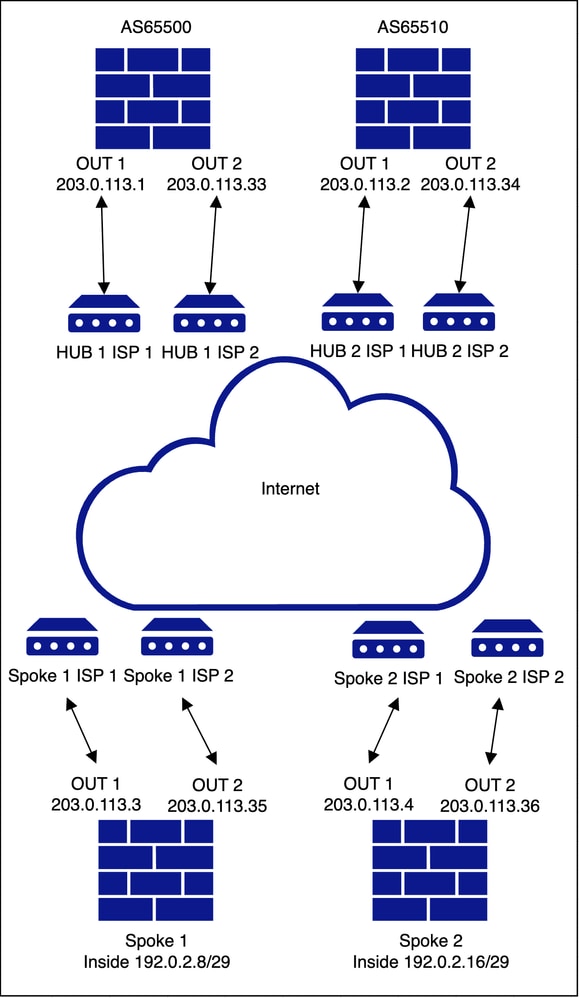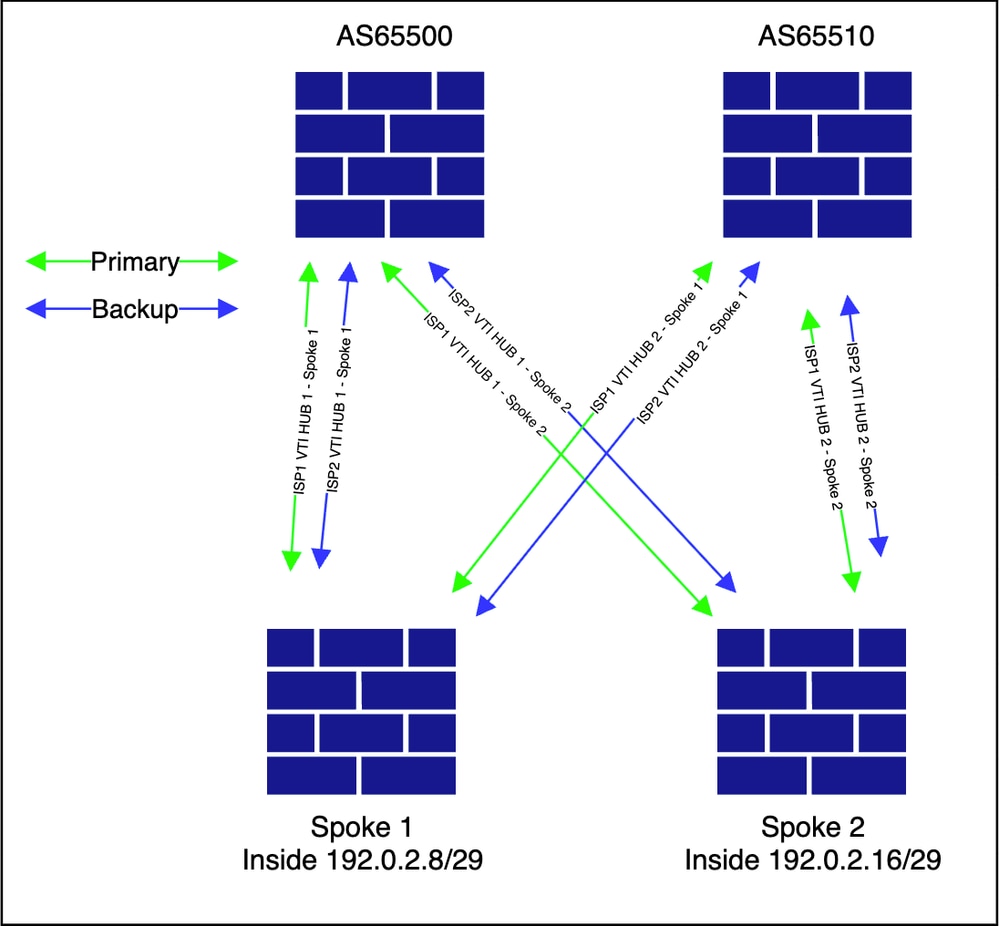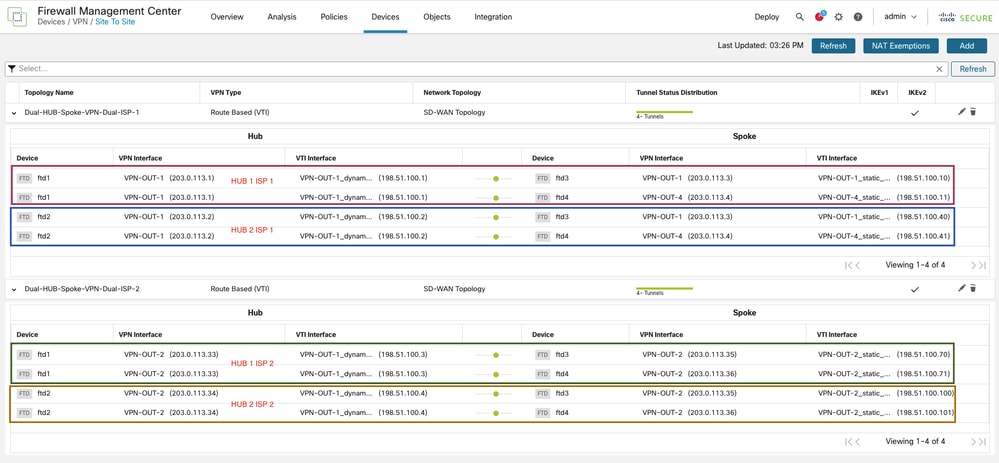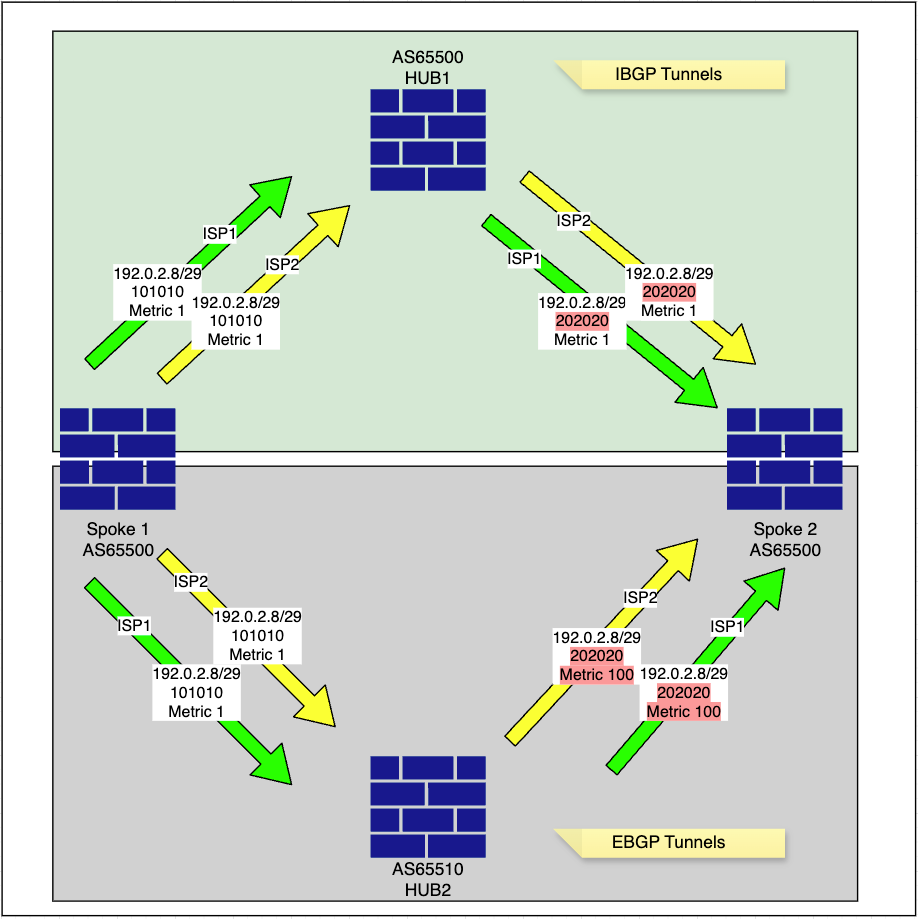Understand and Troubleshoot Route Control in Secure Firewall SD-WAN Deployments
Available Languages
Download Options
Bias-Free Language
The documentation set for this product strives to use bias-free language. For the purposes of this documentation set, bias-free is defined as language that does not imply discrimination based on age, disability, gender, racial identity, ethnic identity, sexual orientation, socioeconomic status, and intersectionality. Exceptions may be present in the documentation due to language that is hardcoded in the user interfaces of the product software, language used based on RFP documentation, or language that is used by a referenced third-party product. Learn more about how Cisco is using Inclusive Language.
Contents
Introduction
This document describes routing control in BGP for route-based VPNs using Cisco SD-WAN on secure firewall.
Prerequisites
Requirements
Cisco recommends that you have knowledge of these topics:
- IKEv2
- Route-based VPN
- Virtual Tunnel Interfaces (VTI)
- IPsec
- BGP
- BGP attributes like community tags and route reflectors
- SD-WAN feature on secure firewall
Components Used
The information in this document is based on:
- Cisco Secure Firewall Threat Defense 7.7.10
- Cisco Secure Firewall Management Center 7.7.10
The information in this document was created from the devices in a specific lab environment. All of the devices used in this document started with a cleared (default) configuration. If your network is live, ensure that you understand the potential impact of any command.
Feature Information
With the new SD-WAN deployment for site-to-site, route-based VPN with BGP enabled for the overlay, Cisco focuses on key BGP attributes to implement loop-free and secure overlay routing, ensuring that underlay and overlay networks remain segregated throughout the topology. This deployment also ensures that no manual intervention is required to adjust the relevant attributes.
Deployment Scenario
Select a topology that includes both iBGP and eBGP connections between the HUB and spoke. This approach provides maximum visibility into the routing controls implemented as part of the SD-WAN solution on Cisco Secure Firewalls.
Dual HUB and Spoke with Dual ISP
Underlay Topology

Overlay Topology

Configuration
Since the primary objective of this document is to provide a clear understanding of the routing control implemented as part of the SD-WAN deployment on Secure Firewall, the foundational configuration steps required to deploy the topology are not revisited again. For detailed guidance on the initial setup, please refer to our previously published document Configure SD-WAN for Site-to-Site VPN over Secure Firewall.
All configurations in the CLI section are applied through the SD-WAN configuration wizard. No changes or modifications are made separately to the BGP configuration or any route-map configurations.

Verify And Troubleshoot
The community list is responsible for filtering both incoming and outgoing prefixes. A detailed explanation can be found in the Community List section of cisco documentation at Cisco Secure Firewall Management Center Device Configuration Guide.
Common Configuration Across All Devices
firepower# show running-config community-list
community-list standard FMC_VPN_COMMUNITY_101010 permit 101010 <<<<<<<<<<
community-list standard FMC_VPN_COMMUNITY_202020 permit 202020 <<<<<<<<<<
Please note that there is a single pair of inbound and outbound route-maps per topology though the configurations are identical for both topologies, just the naming convention is unique per topology. In our scenario, FMC_VPN_RMAP_COMMUNITY_IN_8589939614 and FMC_VPN_RMAP_COMMUNITY_OUT_8589939614 are for topology 1 while FMC_VPN_RMAP_COMMUNITY_IN_8589942200 and FMC_VPN_RMAP_COMMUNITY_OUT_8589942200 are for topology 2.
firepower# show running-config route-map
Topology 1
Inbound
route-map FMC_VPN_RMAP_COMMUNITY_IN_8589939614 permit 10
match community FMC_VPN_COMMUNITY_101010 exact-match
set community 202020
route-map FMC_VPN_RMAP_COMMUNITY_IN_8589939614 permit 20
match community FMC_VPN_COMMUNITY_202020 exact-match
Outbound
route-map FMC_VPN_RMAP_COMMUNITY_OUT_8589939614 permit 10
match community FMC_VPN_COMMUNITY_101010 exact-match
set metric 1
route-map FMC_VPN_RMAP_COMMUNITY_OUT_8589939614 permit 20
match community FMC_VPN_COMMUNITY_202020 exact-match
set metric 100
route-map FMC_VPN_RMAP_COMMUNITY_OUT_8589939614 deny 100
Topology 2
Inbound
route-map FMC_VPN_RMAP_COMMUNITY_IN_8589942200 permit 10
match community FMC_VPN_COMMUNITY_101010 exact-match
set community 202020
route-map FMC_VPN_RMAP_COMMUNITY_IN_8589942200 permit 20
match community FMC_VPN_COMMUNITY_202020 exact-match
Outbound
route-map FMC_VPN_RMAP_COMMUNITY_OUT_8589942200 permit 10
match community FMC_VPN_COMMUNITY_101010 exact-match
set metric 1
route-map FMC_VPN_RMAP_COMMUNITY_OUT_8589942200 permit 20
match community FMC_VPN_COMMUNITY_202020 exact-match
set metric 100
route-map FMC_VPN_RMAP_COMMUNITY_OUT_8589942200 deny 100
Common Across All The Hubs & Spokes Wherever Redistribution Of Inside Network Is Present
route-map FMC_VPN_CONNECTED_DIST_RMAP_101010 permit 10
match interface inside
set community 101010
The BGP configuration across the devices in the topology is shown:
Spoke1 and 2 (IBGP with HUB1 and EBGP with HUB2)
firepower# show running-config router bgp
router bgp 65500
bgp log-neighbor-changes
address-family ipv4 unicast
neighbor 198.51.100.1 remote-as 65500 <<<<< tunnel from spokes to HUB 1 via ISP1
neighbor 198.51.100.1 activate
neighbor 198.51.100.1 send-community
neighbor 198.51.100.1 route-map FMC_VPN_RMAP_COMMUNITY_IN_8589939614 in
neighbor 198.51.100.1 route-map FMC_VPN_RMAP_COMMUNITY_OUT_8589939614 out
neighbor 198.51.100.2 remote-as 65510 <<<<< tunnel from spokes to HUB 2 via ISP1
neighbor 198.51.100.2 ebgp-multihop 2
neighbor 198.51.100.2 activate
neighbor 198.51.100.2 send-community
neighbor 198.51.100.2 route-map FMC_VPN_RMAP_COMMUNITY_IN_8589939614 in
neighbor 198.51.100.2 route-map FMC_VPN_RMAP_COMMUNITY_OUT_8589939614 out
neighbor 198.51.100.3 remote-as 65500 <<<<< tunnel from spokes to HUB 1 via ISP2
neighbor 198.51.100.3 activate
neighbor 198.51.100.3 send-community
neighbor 198.51.100.3 route-map FMC_VPN_RMAP_COMMUNITY_IN_8589942200 in
neighbor 198.51.100.3 route-map FMC_VPN_RMAP_COMMUNITY_OUT_8589942200 out
neighbor 198.51.100.4 remote-as 65510 <<<<< tunnel from spokes to HUB 2 via ISP2
neighbor 198.51.100.4 ebgp-multihop 2
neighbor 198.51.100.4 activate
neighbor 198.51.100.4 send-community
neighbor 198.51.100.4 route-map FMC_VPN_RMAP_COMMUNITY_IN_8589942200 in
neighbor 198.51.100.4 route-map FMC_VPN_RMAP_COMMUNITY_OUT_8589942200 out
redistribute connected route-map FMC_VPN_CONNECTED_DIST_RMAP_101010 <<<<<<< route-map to redistribute inside network into BGP
maximum-paths 8
maximum-paths ibgp 8
no auto-summary
no synchronization
exit-address-family
HUB1 (IBGP Peering with the Spokes)
firepower# show running-config router bgp
router bgp 65500
bgp log-neighbor-changes
address-family ipv4 unicast
neighbor 198.51.100.10 remote-as 65500 <<<<< tunnel from HUB 1 to Spoke 1 via ISP 1
neighbor 198.51.100.10 activate
neighbor 198.51.100.10 send-community
neighbor 198.51.100.10 route-reflector-client
neighbor 198.51.100.10 next-hop-self
neighbor 198.51.100.10 route-map FMC_VPN_RMAP_COMMUNITY_IN_8589939614 in
neighbor 198.51.100.10 route-map FMC_VPN_RMAP_COMMUNITY_OUT_8589939614 out
neighbor 198.51.100.11 remote-as 65500 <<<<< tunnel from HUB 1 to Spoke 2 via ISP 1
neighbor 198.51.100.11 activate
neighbor 198.51.100.11 send-community
neighbor 198.51.100.11 route-reflector-client
neighbor 198.51.100.11 next-hop-self
neighbor 198.51.100.11 route-map FMC_VPN_RMAP_COMMUNITY_IN_8589939614 in
neighbor 198.51.100.11 route-map FMC_VPN_RMAP_COMMUNITY_OUT_8589939614 out
neighbor 198.51.100.70 remote-as 65500 <<<<< tunnel from HUB 1 to Spoke 1 via ISP 2
neighbor 198.51.100.70 activate
neighbor 198.51.100.70 send-community
neighbor 198.51.100.70 route-reflector-client
neighbor 198.51.100.70 next-hop-self
neighbor 198.51.100.70 route-map FMC_VPN_RMAP_COMMUNITY_IN_8589942200 in
neighbor 198.51.100.70 route-map FMC_VPN_RMAP_COMMUNITY_OUT_8589942200 out
neighbor 198.51.100.71 remote-as 65500 <<<<< tunnel from HUB 1 to Spoke 2 via ISP 2
neighbor 198.51.100.71 activate
neighbor 198.51.100.71 send-community
neighbor 198.51.100.71 route-reflector-client
neighbor 198.51.100.71 next-hop-self
neighbor 198.51.100.71 route-map FMC_VPN_RMAP_COMMUNITY_IN_8589942200 in
neighbor 198.51.100.71 route-map FMC_VPN_RMAP_COMMUNITY_OUT_8589942200 out
no auto-summary
no synchronization
exit-address-family
HUB2 (EBGP Peering with the Spokes)
firepower# show running-config router bgp
router bgp 65510
bgp log-neighbor-changes
address-family ipv4 unicast
neighbor 198.51.100.40 remote-as 65500 <<<<< tunnel from HUB 2 to Spoke 1 via ISP 1
neighbor 198.51.100.40 ebgp-multihop 2
neighbor 198.51.100.40 activate
neighbor 198.51.100.40 send-community
neighbor 198.51.100.40 next-hop-self
neighbor 198.51.100.40 as-override
neighbor 198.51.100.40 route-map FMC_VPN_RMAP_COMMUNITY_IN_8589939614 in
neighbor 198.51.100.40 route-map FMC_VPN_RMAP_COMMUNITY_OUT_8589939614 out
neighbor 198.51.100.41 remote-as 65500 <<<<< tunnel from HUB 2 to Spoke 2 via ISP 1
neighbor 198.51.100.41 ebgp-multihop 2
neighbor 198.51.100.41 activate
neighbor 198.51.100.41 send-community
neighbor 198.51.100.41 next-hop-self
neighbor 198.51.100.41 as-override
neighbor 198.51.100.41 route-map FMC_VPN_RMAP_COMMUNITY_IN_8589939614 in
neighbor 198.51.100.41 route-map FMC_VPN_RMAP_COMMUNITY_OUT_8589939614 out
neighbor 198.51.100.100 remote-as 65500 <<<<< tunnel from HUB 2 to Spoke 1 via ISP 2
neighbor 198.51.100.100 ebgp-multihop 2
neighbor 198.51.100.100 activate
neighbor 198.51.100.100 send-community
neighbor 198.51.100.100 next-hop-self
neighbor 198.51.100.100 as-override
neighbor 198.51.100.100 route-map FMC_VPN_RMAP_COMMUNITY_IN_8589942200 in
neighbor 198.51.100.100 route-map FMC_VPN_RMAP_COMMUNITY_OUT_8589942200 out
neighbor 198.51.100.101 remote-as 65500 <<<<< tunnel from HUB 2 to Spoke 2 via ISP 2
neighbor 198.51.100.101 ebgp-multihop 2
neighbor 198.51.100.101 activate
neighbor 198.51.100.101 send-community
neighbor 198.51.100.101 next-hop-self
neighbor 198.51.100.101 as-override
neighbor 198.51.100.101 route-map FMC_VPN_RMAP_COMMUNITY_IN_8589942200 in
neighbor 198.51.100.101 route-map FMC_VPN_RMAP_COMMUNITY_OUT_8589942200 out
no auto-summary
no synchronization
exit-address-family
Routing Topology

-
The spoke advertises its internal network, 192.0.2.8/29, into BGP with a specific community tag of 101010, as configured in the route-map FMC_VPN_CONNECTED_DIST_RMAP_101010.
Spoke1
Spoke1# show bgp community 101010 exact-match <<<< to verify the exact network redistributed into BGP
BGP table version is 4, local router ID is 203.0.113.35
Status codes: s suppressed, d damped, h history, * valid, > best, i - internal,
r RIB-failure, S Stale, m multipath
Origin codes: i - IGP, e - EGP, ? - incomplete
Network Next Hop Metric LocPrf Weight Path
*> 192.0.2.8/29 0.0.0.0 0 32768 ? <<<<<<<<<<< local inside network-
The spoke modifies the metric value for its internal network, 192.0.2.8/29, and advertise it to the hubs, as configured in the route-maps FMC_VPN_RMAP_COMMUNITY_OUT_8589939614 and FMC_VPN_RMAP_COMMUNITY_OUT_8589942200.
route-map FMC_VPN_RMAP_COMMUNITY_OUT_8589942200 permit 10
match community FMC_VPN_COMMUNITY_101010 exact-match
set metric 1
route-map FMC_VPN_RMAP_COMMUNITY_OUT_8589942200 permit 20
match community FMC_VPN_COMMUNITY_202020 exact-match
set metric 100
route-map FMC_VPN_RMAP_COMMUNITY_OUT_8589942200 deny 100
-
HUB1 learns the Spoke 1 network 192.0.2.8/29 with the community tag 101010, and changes the community tag to 202020 while preserving the metric before forwarding it to other spokes, as defined in the configured route-maps.
HUB1
Route-Map for ISP1 DVTI
Inbound
route-map FMC_VPN_RMAP_COMMUNITY_IN_8589939614 permit 10
match community FMC_VPN_COMMUNITY_101010 exact-match
set community 202020
route-map FMC_VPN_RMAP_COMMUNITY_IN_8589939614 permit 20
match community FMC_VPN_COMMUNITY_202020 exact-match
Outbound
route-map FMC_VPN_RMAP_COMMUNITY_OUT_8589939614 permit 10
match community FMC_VPN_COMMUNITY_101010 exact-match
set metric 1
set ip next-hop 198.51.100.1 <<<<<<<<<< only next-hop is changed in ISP2 tunnel route-map with ISP2 DVTI IP
route-map FMC_VPN_RMAP_COMMUNITY_OUT_8589939614 permit 20
match community FMC_VPN_COMMUNITY_202020 exact-match
set metric 100
set ip next-hop 198.51.100.1 <<<<<<<<<< only next-hop is changed in ISP2 tunnel route-map with ISP2 DVTI IP
route-map FMC_VPN_RMAP_COMMUNITY_OUT_8589939614 deny 100
Route-Map for ISP2 DVTI
Inbound
route-map FMC_VPN_RMAP_COMMUNITY_IN_8589942200 permit 10
match community FMC_VPN_COMMUNITY_101010 exact-match
set community 202020
route-map FMC_VPN_RMAP_COMMUNITY_IN_8589942200 permit 20
match community FMC_VPN_COMMUNITY_202020 exact-match
Outbound
route-map FMC_VPN_RMAP_COMMUNITY_OUT_8589942200 permit 10
match community FMC_VPN_COMMUNITY_101010 exact-match
set metric 1
set ip next-hop 198.51.100.3 <<<<<<<<<< only next-hop is changed in ISP2 tunnel route-map with ISP2 DVTI IP
route-map FMC_VPN_RMAP_COMMUNITY_OUT_8589942200 permit 20
match community FMC_VPN_COMMUNITY_202020 exact-match
set metric 100
set ip next-hop 198.51.100.3 <<<<<<<<<< only next-hop is changed in ISP2 tunnel route-map with ISP2 DVTI IP
route-map FMC_VPN_RMAP_COMMUNITY_OUT_8589942200 deny 100
HUB1# show bgp community 202020 exact-match <<<< this will confirm if received prefixes have community tags flipped
BGP table version is 5, local router ID is 198.51.100.3 Status codes: s suppressed, d damped, h history, * valid, > best, i - internal, r RIB-failure, S Stale, m multipath Origin codes: i - IGP, e - EGP, ? - incomplete Network Next Hop Metric LocPrf Weight Path * i192.0.2.8/29 198.51.100.70 1 100 0 ? *>i 198.51.100.10 1 100 0 ? * i192.0.2.16/29 198.51.100.71 1 100 0 ? *>i 198.51.100.11 1 100 0 ?
HUB1# show bgp 192.0.2.8 <<<< this will display available paths in BGP for the network
BGP routing table entry for 192.0.2.8/29, version 4 Paths: (2 available, best #2, table default) Advertised to update-groups: 1 2 Local, (Received from a RR-client) 198.51.100.70 from 198.51.100.70 (203.0.113.35) <<<<< spoke 1 ISP 2 tunnel to HUB 1 Origin incomplete, metric 1, localpref 100, valid, internal Community: 202020 Local, (Received from a RR-client) 198.51.100.10 from 198.51.100.10 (203.0.113.35) <<<<< spoke 1 ISP 1 tunnel to HUB 1 Origin incomplete, metric 1, localpref 100, valid, internal, best Community: 202020 <<<<< community updated as per the route-map configured on spoke side
HUB1# show route 192.0.2.8
Routing entry for 192.0.2.8 255.255.255.248
Known via "bgp 65500", distance 200, metric 1, type internal
Last update from 198.51.100.10 0:09:18 ago
Routing Descriptor Blocks:
* 198.51.100.10, from 198.51.100.10, 0:09:18 ago
Route metric is 1, traffic share count is 1
AS Hops 0
MPLS label: no label string providedHUB1# show bgp ipv4 unicast neighbors 198.51.100.10 routes <<<<<< to check specific prefixes learnt via ISP1 spoke1 tunnel
BGP table version is 5, local router ID is 198.51.100.3
Status codes: s suppressed, d damped, h history, * valid, > best, i - internal,
r RIB-failure, S Stale, m multipath
Origin codes: i - IGP, e - EGP, ? - incomplete
Network Next Hop Metric LocPrf Weight Path
*>i192.0.2.8/29 198.51.100.10 1 100 0 ? <<< preferred route
Total number of prefixes 1 HUB1# show bgp ipv4 unicast neighbors 198.51.100.70 routes <<<<<< to check specific prefixes learnt via ISP2 spoke1 tunnel
BGP table version is 5, local router ID is 198.51.100.3
Status codes: s suppressed, d damped, h history, * valid, > best, i - internal,
r RIB-failure, S Stale, m multipath
Origin codes: i - IGP, e - EGP, ? - incomplete
Network Next Hop Metric LocPrf Weight Path
* i192.0.2.8/29 198.51.100.70 1 100 0 ?
Total number of prefixes 1 -
HUB2 also learns the Spoke 1 network 192.0.2.8/29 with the community tag 101010, and changes the community tag to 202020 and update the metric to 100 before forwarding it to other spokes, as specified in the configured route-maps. This metric change takes effect due to eBGP peering. This is because MED (Multi-Exit Discriminator) is an optional, non-transitive BGP attribute used to influence inbound traffic by suggesting a preferred entry point into an AS. MED is generally not propagated between iBGP peers within the same AS and instead advertised to external BGP (eBGP) peers in different autonomous systems.
HUB2
HUB2# show bgp community 202020 exact-match <<<< this will confirm if receieved prefixes have community tags flipped
BGP table version is 5, local router ID is 198.51.100.4 Status codes: s suppressed, d damped, h history, * valid, > best, i - internal, r RIB-failure, S Stale, m multipath Origin codes: i - IGP, e - EGP, ? - incomplete Network Next Hop Metric LocPrf Weight Path * 192.0.2.8/29 198.51.100.1 100 0 65500 ? <<<<<< advertised back by spoke 2 ISP1 to HUB2 previously learnt via HUB1 iBGP * 198.51.100.1 100 0 65500 ? <<<<<< advertised back by spoke 2 ISP2 to HUB2 previously learnt via HUB1 iBGP * 198.51.100.100 1 0 65500 ? <<<<<< advertised by spoke 2 ISP tunnel *> 198.51.100.40 1 0 65500 ? <<<<<< advertised and preferred by spoke 1 ISP 1 tunnel * 192.0.2.16/29 198.51.100.1 100 0 65500 ? * 198.51.100.1 100 0 65500 ? * 198.51.100.101 1 0 65500 ? *> 198.51.100.41 1 0 65500 ?
HUB2# show bgp 192.0.2.8 <<<< this will display available paths in BGP for the network
BGP routing table entry for 192.0.2.8/29, version 4 Paths: (4 available, best #4, table default) Advertised to update-groups: 1 2 65500 198.51.100.1 (inaccessible) from 198.51.100.41 (203.0.113.36) <<<<<< advertised back by spoke 2 ISP1 to HUB2 previously learnt via HUB1 iBGP Origin incomplete, metric 100, localpref 100, valid, external Community: 202020 65500 198.51.100.1 (inaccessible) from 198.51.100.101 (203.0.113.36) <<<<<< advertised back by spoke 2 ISP2 to HUB2 previously learnt via HUB1 iBGP Origin incomplete, metric 100, localpref 100, valid, external Community: 202020 65500 198.51.100.100 from 198.51.100.100 (203.0.113.35) <<<<<< advertised by spoke 1 ISP 2 tunnel Origin incomplete, metric 1, localpref 100, valid, external Community: 202020 65500 198.51.100.40 from 198.51.100.40 (203.0.113.35) <<<<<< advertised and preferred by spoke 1 ISP 1 tunnel Origin incomplete, metric 1, localpref 100, valid, external, best Community: 202020
HUB2# show bgp ipv4 unicast neighbors 198.51.100.40 routes <<<<<< to check specific prefixes learnt via ISP1 spoke1 tunnel
BGP table version is 5, local router ID is 198.51.100.4 Status codes: s suppressed, d damped, h history, * valid, > best, i - internal, r RIB-failure, S Stale, m multipath Origin codes: i - IGP, e - EGP, ? - incomplete Network Next Hop Metric LocPrf Weight Path *> 192.0.2.8/29 198.51.100.40 1 0 65500 ? <<<< preferred * 192.0.2.16/29 198.51.100.1 100 0 65500 ? Total number of prefixes 2
HUB2# show bgp ipv4 unicast neighbors 198.51.100.41 routes <<<<<< to check specific prefixes learnt via ISP1 spoke2 tunnel
BGP table version is 5, local router ID is 198.51.100.4 Status codes: s suppressed, d damped, h history, * valid, > best, i - internal, r RIB-failure, S Stale, m multipath Origin codes: i - IGP, e - EGP, ? - incomplete Network Next Hop Metric LocPrf Weight Path * 192.0.2.8/29 198.51.100.1 100 0 65500 ? <<<<<< *> 192.0.2.16/29 198.51.100.41 1 0 65500 ? Total number of prefixes 2
HUB2# show bgp ipv4 unicast neighbors 198.51.100.100 routes <<<<<< to check specific prefixes learnt via ISP2 spoke1 tunnel
BGP table version is 5, local router ID is 198.51.100.4 Status codes: s suppressed, d damped, h history, * valid, > best, i - internal, r RIB-failure, S Stale, m multipath Origin codes: i - IGP, e - EGP, ? - incomplete Network Next Hop Metric LocPrf Weight Path * 192.0.2.8/29 198.51.100.100 1 0 65500 ? <<<<<< * 192.0.2.16/29 198.51.100.1 100 0 65500 ? Total number of prefixes 2
HUB2# show bgp ipv4 unicast neighbors 198.51.100.101 routes <<<<<< to check specific prefixes learnt via ISP2 spoke2 tunnel
BGP table version is 5, local router ID is 198.51.100.4
Status codes: s suppressed, d damped, h history, * valid, > best, i - internal,
r RIB-failure, S Stale, m multipath
Origin codes: i - IGP, e - EGP, ? - incomplete
Network Next Hop Metric LocPrf Weight Path
* 192.0.2.8/29 198.51.100.1 100 0 65500 ? <<<<<<
* 192.0.2.16/29 198.51.100.101 1 0 65500 ?
Total number of prefixes 2 -
Spoke 2 receives the Spoke 1 network 192.0.2.8/29 from both the HUB1 ISP1 and HUB1 ISP2 tunnels with a metric of 1, while it receives the same network from the HUB2 ISP1 and HUB2 ISP2 tunnels with an updated next-hop of HUB1.
Spoke 2
Spoke2# show bgp community 202020 exact-match <<<< this will confirm if receieved prefixes have community tags flipped
BGP table version is 8, local router ID is 203.0.113.36 Status codes: s suppressed, d damped, h history, * valid, > best, i - internal, r RIB-failure, S Stale, m multipath Origin codes: i - IGP, e - EGP, ? - incomplete Network Next Hop Metric LocPrf Weight Path *mi192.0.2.8/29 198.51.100.3 1 100 0 ? *>i 198.51.100.1 1 100 0 ? <<<< HUB1 ISP1 route preferred * 198.51.100.2 100 0 65510 65510 ? * 198.51.100.4 100 0 65510 65510 ? * 192.0.2.16/29 198.51.100.4 100 0 65510 65510 ? * 198.51.100.2 100 0 65510 65510 ?
route-map FMC_VPN_RMAP_COMMUNITY_IN_8589939614 permit 10
match community FMC_VPN_COMMUNITY_101010 exact-match
set community 202020
route-map FMC_VPN_RMAP_COMMUNITY_IN_8589956263 permit 20
match community FMC_VPN_COMMUNITY_202020 exact-match
-
Spoke 2 also advertises networks learned from HUB1 back to HUB2, as defined by the configured outbound route-map, with the updated metric.
route-map FMC_VPN_RMAP_COMMUNITY_OUT_8589939614 permit 10
match community FMC_VPN_COMMUNITY_101010 exact-match
set metric 1
route-map FMC_VPN_RMAP_COMMUNITY_OUT_8589939614 permit 20
match community FMC_VPN_COMMUNITY_202020 exact-match
set metric 100 <<<<<
route-map FMC_VPN_RMAP_COMMUNITY_OUT_8589939614 deny 100
Spoke2# show bgp ipv4 unicast neighbors 198.51.100.2 advertised-routes <<<<< to check specific prefixes advertised via ISP1 HUB2 tunnel back to HUB2
BGP table version is 8, local router ID is 203.0.113.36
Status codes: s suppressed, d damped, h history, * valid, > best, i - internal,
r RIB-failure, S Stale, m multipath
Origin codes: i - IGP, e - EGP, ? - incomplete
Network Next Hop Metric LocPrf Weight Path
*>i192.0.2.8/29 198.51.100.1 1 100 0 ? <<<<<<<
*> 192.0.2.16/29 0.0.0.0 0 32768 ?
Total number of prefixes 2 Spoke2# show bgp ipv4 unicast neighbors 198.51.100.4 advertised-routes <<<<< to check specific prefixes advertised via ISP2 HUB2 tunnel back to HUB2
BGP table version is 8, local router ID is 203.0.113.36
Status codes: s suppressed, d damped, h history, * valid, > best, i - internal,
r RIB-failure, S Stale, m multipath
Origin codes: i - IGP, e - EGP, ? - incomplete
Network Next Hop Metric LocPrf Weight Path
*>i192.0.2.8/29 198.51.100.1 1 100 0 ? <<<<<<<
*> 192.0.2.16/29 0.0.0.0 0 32768 ?
Total number of prefixes 2Conclusion
The purpose of this document is to provide a walkthrough of the backend routing deployment, with a focus on the routing controls implemented within BGP to ensure both contingency and redundancy.
In summary, spoke 2 as well as any other spokes in the topology uses the same approach when advertising their networks into the BGP domain. The most important routing control in this scenario is community list filtering, which ensures that only networks within this topology are advertised to other peers, preventing unintended network propagation.
Additionally, the MED Multi-exit Discriminator attribute is used to influence route selection for eBGP peers, ensuring that routes learned via the iBGP peer configured as the primary HUB are preferred over prefixes learned from the secondary HUB via eBGP.
By making topology adjustments, such as configuring iBGP for the secondary HUB, you can eliminate the need for MED manipulation and inbound route-maps that flip community tags before advertising the same network to other spokes.
Related Information
- For additional assistance, please contact TAC. A valid support contract is required:Cisco Worldwide Support Contacts.
- You can also visit the Cisco VPN Community for additional insights and trending discussions.
Revision History
| Revision | Publish Date | Comments |
|---|---|---|
1.0 |
01-Oct-2025
|
Initial Release |
Contributed by Cisco Engineers
- Daniyal AkhtarTechnical Consulting Engineer
Contact Cisco
- Open a Support Case

- (Requires a Cisco Service Contract)
 Feedback
Feedback